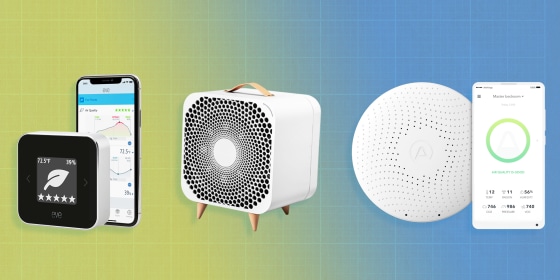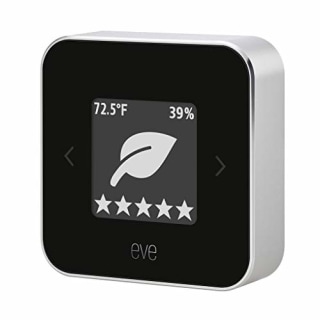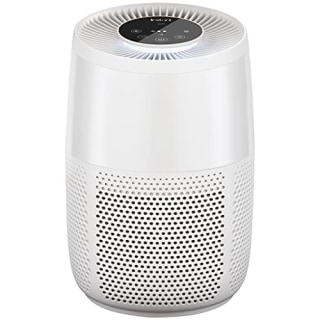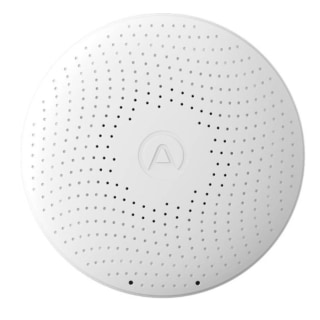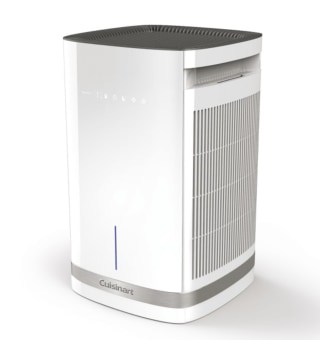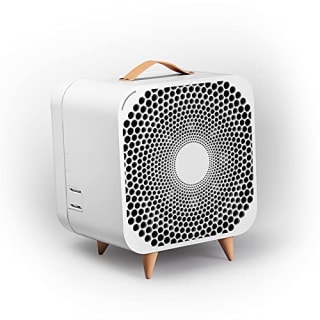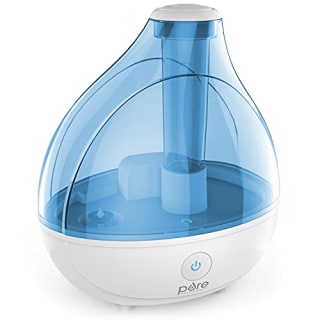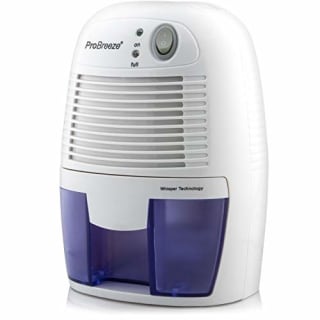Since the pandemic first forced people to spend more time at home, many have invested in products to filter the air they breathe indoors. Devices that monitor or improve indoor air quality, like air purifiers, have been flying off the shelves.
And it’s not just about Covid-19, which is primarily spread through airborne particles. If you live in an area with frequent wildfires, these devices can help filter out harmful smoke.
Now, after a spring and summer in which we could enjoy the outdoors, the cold weather months will soon force us indoors again — and indoor air quality is going to be on many people’s minds, especially as the delta variant rages on.
SKIP AHEAD Air quality monitors | Other products for improving air quality in small spaces
Those who live in small spaces like apartments and dorm rooms have to pay special attention to indoor air quality, according to Reza Ronaghi, MD, who specializes in interventional pulmonology at UCLA Health in Los Angeles. First of all, infectious diseases like Covid and the flu are more easily transmitted in a small, enclosed space, especially the more people there are in it. Secondly, people in a small, enclosed space are more likely to notice and be harmed by air pollution, like from smoke or noxious gases.
“The way to think about it is if a certain number of particles enter a large house and they have a larger space to spread out, the number of particles you inhale is lower,” Ronaghi said. “Whereas if you put that same number of particles in a small room or a small, enclosed space, the number of particles you inhale is greater.”
Many modern apartment buildings and dorms feature central cooling and heating systems, said John McKeon, CEO of Allergy Standards, a global organization that certifies safer products for people with asthma or allergies. This means residents don’t have much, if any, control over the air pumped through their vents or knowledge of where it’s coming from. McKeon said that, in these situations, people also don’t have control over how often filters are changed or ducts are cleaned, which means the air that arrives in their small space could be polluted, dry, humid or stale.
There are many products you can use to monitor and improve air quality in your small space. But before you buy, McKeon said, it’s important to decide what you need. Are you looking to filter pollutants out of the air or increase air circulation? That may mean you need an air purifier or fan. Or is your air too dry or too humid? That may call for a humidifier or dehumidifier.
We spoke to experts about how to monitor and improve air quality in small spaces, which products are useful and why. They shared specific features you may want to look for when buying items for your apartment or dorm.
Buying air quality devices for small spaces
The first thing you have to take into consideration is space — or lack thereof. There’s not often room in small apartments for multiple devices or big, bulky models. And if your living and sleeping spaces blend into one another, you won't want noisy machines or bright displays that will keep you up at night.
Experts told us there is no exact definition for a “small” space or a specific number of square feet that qualifies an apartment or dorm room, for example, as a small space. However, according to a 2014 report from the Urban Land Institute, a nonprofit organization that studies land use, the “working definition” of a microunit “is a small studio apartment, typically less than 350 square feet, with a fully functioning and accessibility compliant kitchen and bathroom” — although the minimum size for apartments varies depending on the city in which you live. Dorm rooms that share communal bathrooms and kitchens do not qualify as microunits under this definition, but they can range in size — in college, I lived in about a 300-square-foot room with a roommate and then by myself in an approximately 100-square-foot room.
Ronaghi suggested looking for products that serve multiple purposes. For example, some air purifiers come with built-in air quality monitors, and some fans also purify air. McKeon recommended buying devices that offer sleep modes or allow you to turn off display lights. He also noted that some air quality devices can be noisy — quieter purifiers can make a big difference in small spaces.
It’s important to note that the products experts recommended as worth considering are designed to be exclusively used indoors. While outdoor air quality can impact indoor air quality — for example, if you open a window and let smoky, polluted outdoor air inside — devices like air purifiers and dehumidifiers should only be used indoors.
How to monitor air quality in small spaces
Why do you even need a monitor for air quality at all? There often aren't signs you can see or feel that indicate how good or bad the air is in your home, Ronaghi said.
“Even though it may look clear and you may not be able to smell something, it does not necessarily mean there’s good air quality,” he said. “We are talking about particles that are micromillimeters in size, and so most of these are not going to be visible and may not even be detected unless you have a device that actually measures air quality.”
(The micron is the standard unit for particle filtration you’ll see across feature listings for products like air purifiers. A micromillimeter is 0.0001 microns. The virus that causes Covid is about 0.1 microns.)
Top-rated air quality monitors
Based on the guidance we received from our experts and our previous recommendations, we selected some top-rated products that have the features and standards that they said would help people dealing with bad air in small spaces.
Air quality monitor
Eve Room Indoor Air Quality Monitor
Air quality monitors measure how much particulate matter is in the air, as we’ve previously reported in our guide to air quality monitors. Some models only measure overall air quality, while others also measure specific factors like carbon dioxide or air pressure. Ronaghi said air quality monitors are a good starting point when it comes to identifying possible issues with your indoor air.
The Eve Room Indoor Air Quality Monitor is Apple HomeKit-enabled and Bluetooth-equipped. In addition to its built-in screen, the device is compatible with Apple devices like the iPhone or iPad so you can keep track of your home’s indoor air quality, temperature and humidity using the companion app. The device stands about 2 inches tall — you can station it on a shelf or bookcase in your small space without it taking up a lot of room. It works with Siri voice commands and is powered by a built-in USB-rechargeable battery that lasts for about six weeks.
Air purifier with a built-in air quality monitor
Instant Air Purifier
“If you can purchase an air purifying machine with some form of air quality indicator, that’s always best,” since you get the benefit of both products in one, Ronaghi said.
The Instant Air Purifier is specially designed for rooms up to 126 square feet. It removes allergens and smoke from the air through a three-stage filtration system and has a sensor that monitors air quality and adjusts the fan speed accordingly in auto mode. Instant said the device also works to remove airborne bacteria, mold and viruses — including Covid — and its light sensor turns off displays and lowers the noise in night mode.
Carbon dioxide monitor
Airthings Wave Plus
Carbon dioxide monitors are “like the canary in the coal mine” when it comes to monitoring indoor air quality, McKeon said. They measure levels of the gas to give a sense of how much fresh air is circulating.
“A carbon dioxide monitor is a very good proxy for air exchange and ventilation,” McKeon said. “If you build up carbon dioxide indoors, it will tell you that ventilation and air quality is not as good as it could be in your space.”
The Wave Plus air quality monitor from Airthings specifically monitors carbon dioxide levels indoors, as well as dangerous substances like the radioactive gas radon. The device pairs with your phone or tablet via Bluetooth, and its app and online dashboard keep you updated on air quality. The monitor can be mounted on the wall or ceiling, and its color-coded rings change based on what it’s measuring.
How to improve air quality in small spaces
When people want to improve the air quality in their home, many immediately think about using an air purifier. But an air purifier may not be the solution you need. If your air is too dry or humid, for example, an air purifier won’t help change that. An air quality monitor can help narrow down what products will actually be beneficial.
Top-rated products for improving air quality in small spaces
Based on our experts’ guidance and our previous recommendations, we rounded up top-rated purifiers, humidifiers, dehumidifiers and fans that could help people improve the air in their small apartments or offices.
Air purifier with a HEPA filter
Cuisinart Purxium Countertop Air Purifier
While you ideally want to purchase an air purifier with a built-in air quality monitor, buying one with a high efficiency particulate air, or HEPA, filter is also important.
“Even if the device may not be able to give you a number for your air quality inside the room, you will be filtering out all the pollutants and all the bad stuff in that room,” Ronaghi said.
Cuisinart’s smaller air purifier is designed to sit on countertops, coffee tables or desks. It can clean the air in a room of up to 500 square feet and features a HEPA filter, active carbon filters and washable, reusable metal filters. It has a timer and an automatic shutoff, and you can choose from four fan speeds.
Portable fan
Treva Portable Desktop Fan
One of the ways the Centers for Disease Control and Prevention suggests improving ventilation indoors is to open the windows. However, the windows in some apartment buildings and dorms don’t open, or, if they do, they open just a crack. In those cases, Ronaghi said, “a simple fan is going to at least be able to increase air circulation.”
This desktop fan is portable, so you can move it around your small space without worrying about it getting in the way. It offers low and high speeds and is battery operated.
2-in-1 fan and air purifier
Blueair Pure Fan Auto
“A combination of an air purifier and a fan will help increase air circulation in small spaces and remove some of those pollutants and particles,” Ronaghi said.
It will also save you space in an apartment or dorm room, so you don’t have to find room for two separate devices.
The Blueair Pure Fan Auto acts as three devices in one: an air purifier, fan and air quality monitor. It’s built with the brand’s HEPASilent filtration technology to capture particles and also features a prefilter. It provides a gentle cooling stream of air and has an air quality indicator built in, which displays one of three colors to communicate its reading. In auto mode, the Pure Fan Auto increases its fan speed if it detects air pollution rising and slows down once it senses that the air is clean.
Humidifier
Pure Enrichment MistAire Ultrasonic Cool Mist Humidifier
If the air is too dry, it can irritate your eyes and exacerbate allergies, McKeon said. Thus, you need to add moisture into the air, which is what a humidifier does.
As recommended in our guide to humidifiers, Pure Enrichment’s MistAire model comes with a 1.5-liter water tank, offering up to 25 hours of continuous operation and 250 square feet of coverage. You can select between high and low speeds, and the device features an optional night light as well as an automatic shutoff. The device utilizes ultrasonic technology, too, which runs quietly so you can use it while you’re sleeping.
Dehumidifier
Pro Breeze Electric Mini Dehumidifier
If there’s condensation on your windows, there’s too much moisture in the air inside. This can lead to mold buildup, which, especially in a small enclosed space, can trigger allergies and asthma, McKeon said. Dehumidifiers remove some of that moisture from the air.
The Pro Breeze Electric Mini Dehumidifier, featured in our guide to dehumidifiers, covers up to 215 square feet. It has a 16-ounce water tank and automatically shuts off when it’s full. The device is lightweight, too, allowing you to easily move it. The brand said this dehumidifier is marketed as “whisper quiet,” so it won’t disturb you while you’re sleeping.
Catch up on Select's in-depth coverage of personal finance, tech and tools, wellness and more, and follow us on Facebook, Instagram and Twitter to stay up to date.

